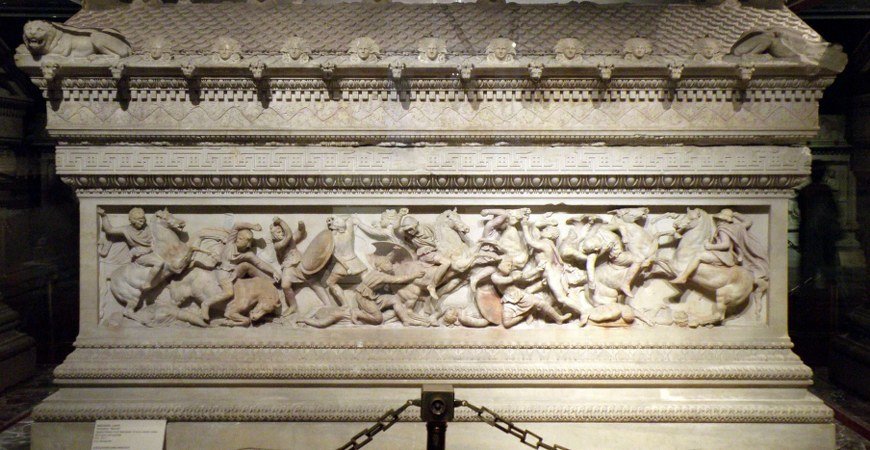
The Alexander Sarcophagus in Archaeological Museum of Istanbul
The Alexander Sarcophagus in Archaeological Museum of Istanbul,
One of the world’s unparalleled masterpieces is the Alexander Sarcophagus which has been on exhibit in Istanbul Archaeological Museum for 87 years. It is to Istanbul Archaeological Museum what the Mona Lisa is to the Louvre or the decorated Sarcophagus of Cleopatra to the British Museum.
The discovery of this masterpiece of art which was made at the beginning of the fourth century BC is an interesting story: The well-known painter and scholar Osman Hamdi Bey was appointed as Director of Istanbul Archaeological Museum. He first oorganizedTurkish museum studies by having an Antiquities Act passed which made it illegal for antiquities to be smuggled out of the country. After that, he carried out archaeological excavations in previously unknown historical centers in the Ottoman Empire. He uncovered large statues dating from the Komagene Kingdom during excavations at Emerald Mountain near Adiyaman for example. In 1887 he received news that there were certain works of antiquity buried near Sayda, which is today part of the Lebanon. A farmer called Serif in Sayda had come across a grave room while he was plowing his field. When the soil had been removed from over the door of the room he saw that it contained several marble sarcophagi and he notified the authorities, who sent a telegraph to Istanbul. Upon hearing the news Osman Hamdi Bey left for Sayda and began excavating. The site turned out to be an underground necropolis of the Phrygian Kings. Within a few months, more than twenty stone and marble sarcophagi were removed from the grave rooms, among them those of Alexander and the Weeping Women.
Now the sarcophagi were above ground but the problem did not end there. To transport these works, weighing tons, to Istanbul without damage was a still greater problem. No ship would take the responsibility of carrying these works which were as heavy as they were valuable. However in the end agreement was reached with a cargo ship. As the Alexander Sarcophagus was winched onto the ship Osman Hamdi Bey tied himself to the sarcophagus too to prevent any harm coming to it.
The sarcophagi got to Istanbul safe and sound and were exhibited in the museum, where all of Istanbul came rushing to see them. Taking advantage of this widespread interest Osman Hamdi Bey proposed to the Ottoman Sultan that a modern museum building is constructed. The Sultan agreed and in 1891 this new building, which houses the Archaeological Museum today, was completed, and the sarcophagi placed in this museum.
The Alexander Sarcophagus is in the form of a temple, constructed of marble and 2.12 m. high, 3.18 m. long and 1.67 m. wide. .0n its two long sides are bas-reliefs depicting Alexander’s wars with the Persians, which is the reason why it was named the Alexander Sarcophagus. Experts say that it is not actually that of Alexander.
As you know the Macedonian King Alexandra the Great became ill while on the shore of the Indus river and went back to his palace in Babylon. He died in Babylon on June 13, 323 BC. His body was taken to Alexandria in Egypt and there buried. However, the Alexander Sarcophagus was constructed in the fourth century either during his lifetime or just after his death.
One of the long sides of the sarcophagus depicts Alexandra on a rearing horse, with a lion skin on his shoulders. He has a lance in his hand and is preparing to throw it at one of the Persian cavalries. The other long side depicts Alexander as a young warrior carrying the symbol of kingship. All four faces of the sarcophagus are filled with a mythological depiction of Alexander’s bloody battles with the Persian army. The pointed roof of the sarcophagus is also decorated with bas-reliefs which were originally painted, but the paint has worn off except for a few scattered traces. Various stories are told about the Alexander Sarcophagi. For example, it’s said that when the German Emperor Wilhelm II visited Istanbul he asked the sultan for this sarcophagus. When the St Ran asked Osman Hamdi Bey what the thought of this idea, Osman Hamdi Bey was outraged:
This sarcophagus is worth a nation in itself, he replied. I do not suppose that my Sultan wishes to present one of his nations to an emperor. If such a thing happens decree that it should be dragged away over my body. This reply ensured that the sarcophagus stayed in its place.